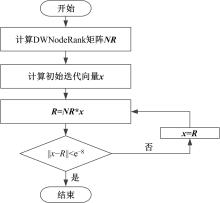Journal of Jilin University(Engineering and Technology Edition) ›› 2022, Vol. 52 ›› Issue (1): 63-69.doi: 10.13229/j.cnki.jdxbgxb20200730
Previous Articles Next Articles
Fault propagation impact assessment of machining center components
Gui-xiang SHEN( ),Lan LUAN,Ying-zhi ZHANG(
),Lan LUAN,Ying-zhi ZHANG( ),Li-ming MU,Shu-bin LIANG
),Li-ming MU,Shu-bin LIANG
- College of Mechanical and Aerospace Engineering,Jilin University,Changchun 130022,China
CLC Number:
- TG659
| 1 | Muchnik L, Aral S, Taylor S J. Social influence bia:a randomized experiment[J]. Science,2013, 341(6146):647-651. |
| 2 | Morone F, Makse H A. Influence maximization in complex networks through optimal percolation[J]. Nature, 2015, 524(7563):65-68. |
| 3 | Freeman L C. A set of measures of centrality based on betweenness[J]. Sociometry, 1977, 40(1):35-41. |
| 4 | Poulin R, Boily M C, Mâsse B R. Dynamical systems to define centrality in social networks[J]. Social Networks, 2000, 22(3):187-220. |
| 5 | Chen D B, Gao H, Zhou T, et al. Identifying influential nodes in large-scale directed networks:the role of clustering[J]. PLoS One, 2013, 8(10):No. e77455. |
| 6 | Brin S, Page L. The anatomy of a large-scale hypertextual web search engine[J]. Computer Networks and ISDN Systems, 1998, 30(1-7):107-117. |
| 7 | 胡庆成,尹龑燊,马鹏斐,等. 一种新的网络传播中最有影响力的节点发现算法[J]. 物理学报, 2013, 62(14):9-19. |
| Hu Qing-cheng,Yin Yan-shen,Ma Peng-fei,et al. A new approach to identify influential spreaders in complex networks[J]. Acta Physica Sinica, 2013, 62(14):9-19. | |
| 8 | 刘影. 复杂网络中节点影响力挖掘及其应用研究[D]. 成都:电子科技大学航空航天学院, 2016. |
| Liu Ying. Research on ranking the influence of nodes on complex networks and its application[D]. Chengdu:School of Aeronautics and Astronautics, University of Electronic Science and Technology of China, 2016. | |
| 9 | Kitsak M, Gallos L K, Havlin S, et al. Identification of influential spreaders in complex networks[J]. Nature Physics, 2010, 6: 888-893. |
| 10 | Bao Z K, Ma C, Xiang B B, et al. Identification of influential nodes in complex networks:method from spreading probability viewpoint[J]. Physica A: Statistical Mechanics and its Applications, 2017, 468: 391-397. |
| 11 | 阮逸润,老松杨,王竣德,等. 一种改进的基于信息传播率的复杂网络影响力评估算法[J]. 物理学报,2017, 66(20):312-322. |
| Ruan Yi-run, Lao Song-yang, Wang Jun-de, et al. An improved evaluating method of node spreading influence in complex network based on information spreading probability[J]. Acta Physica Sinica, 2017, 66(20):312-322. | |
| 12 | 赵之滢, 于海, 朱志良, 等. 基于网络社团结构的节点传播影响力分析[J]. 计算机学报, 2014, 37(4):753-766. |
| Zhao Zhi-ying, Yu Hai, Zhu Zhi-liang, et al. Identifying influential spreaders based on network community structure[J]. Chinese Journal of Computers, 2014, 37(4):753-766. | |
| 13 | Morone F, Makse H A. Influence maximization in complex networks through optimal percolation[J]. Nature, 2015, 524(7563): 65-68. |
| 14 | 胡满玉. 基于链接关系的有向加权复杂网络关键节点识别技术研究[D]. 南京:南京理工大学计算机科学与工程学院, 2012. |
| Hu Man-yu. Research on key node recognition technology of directed weighted complex network based on link relationship[D]. Nan Jing:School of Computer Science and Engineering, Nanjing University of Science and Technology, 2012. | |
| 15 | 李庆扬,王能超,易大义. 数值分析[M]. 北京:清华大学出版社, 2008. |
| [1] | YANG Zhao-jun, YANG Chuan-gui, CHEN Fei, HAO Qing-bo, ZHENG Zhi-tong, WANG Song. Parameter estimation of reliability model of machining center based on particle swarm optimization and support vector regression [J]. 吉林大学学报(工学版), 2015, 45(3): 829-836. |
| [2] | WANG Xiao-feng, SHEN Gui-xiang, ZHANG Ying-zhi, GU Dong-wei, LI Huai-yang, LIU Wei. Prioritizing failures of abc-axis feeding systems based on improved criticality and DEMATEL method [J]. 吉林大学学报(工学版), 2012, 42(01): 122-127. |
| [3] | WANG Xiao-feng, SHEN Gui-xiang, ZHANG Ying-zhi, ZHANG Li-min, WANG Zhi-qiong, LIU Wei. Simulation of reliability and maintainability influence of machining center [J]. 吉林大学学报(工学版), 2011, 41(增刊1): 160-163. |
| [4] | WANG Xiao-feng,SHEN Gui-xiang,ZHANG Ying-zhi,CHEN Bing-kun,LI Huai-yang. Analysis on risk priority number of critical component of machining center based on group decision-making and various assignment ways [J]. 吉林大学学报(工学版), 2011, 41(6): 1630-1635. |
|
||



